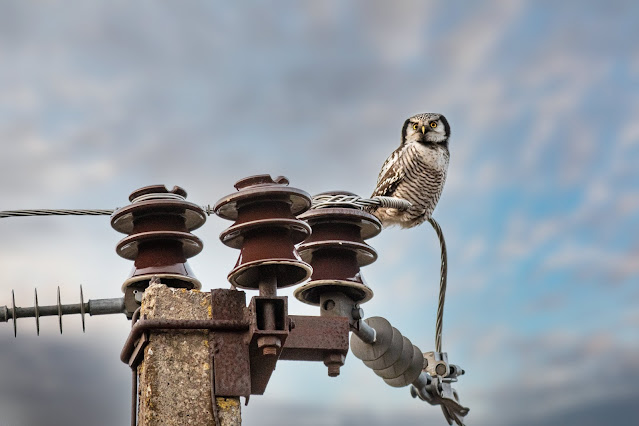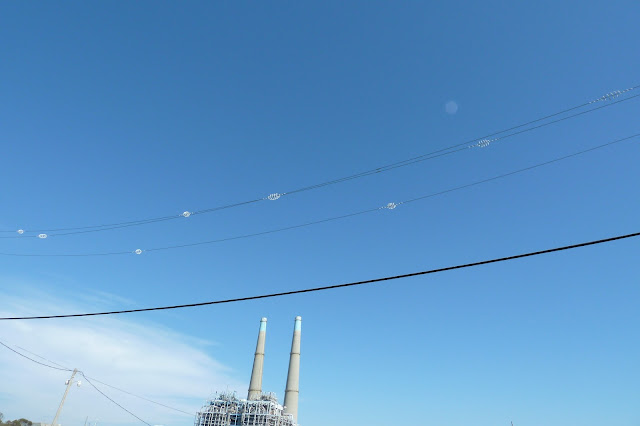 |
| An owl perched on an electrical post. Image credit: Erik Karits via Pexels.com |
You might have thoroughly enjoyed the sight of colorful birds of all shapes and sizes perched on electric cables along the highway. They are a delight to watch. However, for the birds, and sometimes even for us, it is just a disaster waiting to happen. Every year, millions of birds, including many threatened species like the critically endangered great Indian bustard, die due to electrocution upon coming in contact with overhead high-tension power lines. On some occasions, the scorched birds have also caused catastrophic wildfires, leading to human deaths. It is a worldwide conservation issue but with some simple solutions - the best of which has been demonstrated by the tiny Himalayan Kingdom of Bhutan in the remote and ethereal Phobjikha Valley to save the migratory black-necked cranes, considered "the birds of heaven" by the locals there.
How Birds Survive Power Lines But Can Also Die
Before discussing why birds die due to power lines, it is important to know how all those winged beauties are able to line up like stars of the show on power cables without a care in the world. There is Science behind that, not a miracle. In simple words, and forgive my limited knowledge of physics, electricity is all about the flow of electrons from a region of high potential to one at a lower potential, and the flow is best through conductors of electricity like metals. Insulators like rubber arrest the flow of electrons. In the case of a bird, its feathers act as good insulators, and when perched on a single electric wire, its two feet are at the same electric potential, which means there is no potential difference for electrons to flow through its body.
 |
| An electrocuted New Zealand falcon rescued by conservation authorities. Image credit: Ed Waite, New Zealand Department of Conservation via Wikimedia Commons. |
Now comes what is a "disaster waiting to happen." Suppose the bird touches another electric wire at a different potential with one of its feet or an outstretched wing. In that case, there is a chance of a circuit being complete with the potential difference between the two body parts of the bird allowing electricity to flow through its body, leading to an unfortunate consequence. Also, if the bird is sitting on a wooden pole buried deep underground and happens to touch an electric wire with a body part, current can flow from the wire to the ground via the bird's body, killing it. Birds, especially heftier ones that are unable to change their flight direction in a short time, also die upon collision with electric power lines if they cannot detect the electric wires while flying. By the time they realize the presence of the obstruction on their way, it is too late. In such cases, physical impact with the wires and/or electrocution can claim the bird's life.
Figures That Are Truly Shocking
Across the world, electric cables are snatching away the lives of millions of birds. A research survey in the United States revealed that between 12 and 64 million birds are killed annually in the country alone due to power lines. Another study conducted across a 4,200 km² area in India's Thar Desert estimated that around 87,966 birds die in the area due to power lines per year, with large-bodied and ground-dwelling birds being most susceptible. According to the Wildlife Institute of India, an estimated 18 Great Indian bustards die each year in India upon collision with power lines. The figure might look small, but considering only around 150 individuals of this species are left in the wild, one might point out overhead electric poles as the primary cause of the demise of the species. Another very recent shocking discovery, published in the journal Science, revealed that it is not just collision and electrocution-related deaths, but power lines are also deadly for birds in a more sinister way. In a survey across four western US states, dead birds found along power lines had bullets in them, implying that hunters killed them, taking advantage of the easy availability of birds perched on power lines.
 |
| Wildfires such as these can be triggered by electrocuted birds. Image credit: US Fish and Wildlife Service Headquarters via Flickr.com |
Loss of birds have massive detrimental effects on ecosystems as birds are pollinators of innumerable plant species and also predate on many animals. Their steady decline will definitely disrupt the ecological balance that will affect us all in the long run. However, electrocuted birds can also have catastrophic consequences on human lives and property. Bird electrocution events can cause major power outages and loss of funds for electric companies in repairing damaged lines. Also, scorched birds landing on dry vegetation after electric shock are nothing but fire-triggers. For example, a 2014 wildfire that ravaged central Chile, killing at least 13 people and destroying thousands of homes, was possibly caused by an electrocuted bird. The same cause is attributed to a wildfire in Idaho a year later that destroyed around 4000 acres of land. All of the above just shows us the intensity of the issue of bird deaths due to electric poles. But what are the measures to combat this great enemy of our avian friends?
Solutions Are Many, But How Strong Is The Will To Implement?
 |
| Bird diverters on Sandholt Road in Moss Landing, California, helping to make the electric cables more visible to the birds. Image credit: Hydrargyrum via Wikimedia Commons. |
Unlike some of the other global issues like climate change and habitat loss that demand complex, multifaceted solutions, the problem of bird deaths due to overhead electric cables is relatively more easily preventable. However, what is lacking is a will to implement such solutions among governments, electricity corporations, and the public at large.
Some mitigation measures suggested by experts include reconfiguration of electric lines, proper insulation of live electric wires, and the use of perch deterrents and deflectors - all this might cost the electrical companies a tad extra, but are worth the trouble, saving both bird and humans lives, and preventing power outages and wildfires.
 |
| A Great Indian bustard taking flight. Image credit: Madhukar Bangalore via Flickr.com |
However, perhaps the most foolproof solution is to put the high-voltage power lines underground. In 2021, the Supreme Court of India directed the governments of Rajasthan and Gujarat, the Indian states with the last remaining Great Indian bustard populations, to install all the power lines crisscrossing the bird's habitat underground. However, around two years after the order, little action was taken, and worse still, there are plans to install new overground power lines in the area. With the species' survival hanging only by a thread, every single electric cable installed in the area without mitigation measures is equivalent to pushing the Great Indian bustard to a sure extinction.
The Himalayan Kingdom Of Bhutan Leads The Way
With all the sad news around, there is also a glimmer of hope coming from a remote country nestled in the lap of the mighty Himalayas - Bhutan - a place where the government and the people have joined hands to ensure that development happens the correct way.
Every year around late October, the people of the Phobjikha Valley of the country, located at an elevation of around 3,100 m, gear up to welcome some very special winged visitors to their land - the black-necked cranes from Tibet. On November 11, the people of the valley sing and dance in the ancient Gangtey Monastery to welcome the cranes that they consider a good omen. At the same time, they also ensure that the birds find themselves very safe during their time in the valley for which they restrict any kind of human disturbance in the birds' habitats in the valley's wetlands. But going beyond that, they have also ensured that no black-necked crane dies from electrocution.
Video: The ethereal Phobjikha Valley of Bhutan.
Grid electricity came to the valley just more than a decade back, before which the people relied on kerosene and pine wood resin lamps, and later solar power. However, the Royal Society for Protection of Nature (RSPN), a citizen-based NGO in the country in partnership with the country's government, and the people of the valley knew that while establishing the electric grid was vital to the valley's growth, equally important was protecting the birds that were integral to their culture and also tourism economy. So, it was decided to put most of the electric lines underground and those near the forest along the tree line to allow the birds safe passage. The funding for such infrastructure was greatly lacking, but the people waited patiently. Their patience bore fruit when foreign funds and that of their government's combined to give them the electric infrastructure they so desired. Today, the Phobjikha Valley is a haven for the migratory black-necked cranes, with hundreds visiting the valley every winter.
Video: Guru, a tourist guide of Bhutan, talks about how the people of the Phobjikha Valley ensure safety to the visiting black-necked cranes.
"A good deed is never lost," it is said, and the people of Phobjikha today are also greatly benefitting from the cranes whose appearance in the valley draws tourists from across the world to this slice of heaven on Earth.
Writer: Dr. Oishimaya Sen Nag

No comments:
Post a Comment